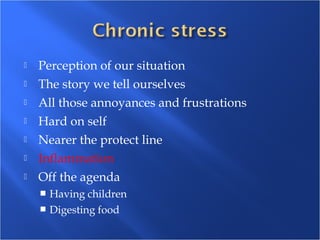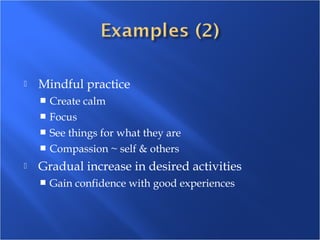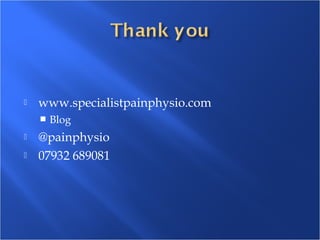Women and pain
- 1. Richmond M. Stace MCSP MSc (Pain) BSc (Hons) Specialist Pain Physiotherapist
- 2. What is the issue? What is pain? Illustration What can we do?
- 3. …one of your patients A women suffering pain What was the story? How did she present? What were the problems?
- 4. Pain causes suffering 2nd arrow Pain limits our choices At home At work Socially Pain affects Our thinking Emotions Perceptions Sense of self
- 5. Visit doctor more than men Use more pain relief Suffer more pain ailments IBS, TMD, fibromyalgia Report more clinical pain
- 6. There are sex differences Biologically e.g./ hormones Perception of women in pain Different treatment Time to receive Rx Much of the research in males This MUST change
- 7. Chronic pain & depression => top 2 global health burdens Figures 100 million Americans 20% of the population 1:5 children
- 8. Medical school Healthcare professional training Postgraduate training CPD
- 9. Pain huge global health burden Main reason why people see doctor or healthcare professional Poor understanding of pain Outcomes?
- 11. Lack of compassion for self Perfectionist Giving to others but not self Minimal or no recharge time Frequent feelings of anxiety & worry Feelings of guilt
- 12. Starts with musculoskeletal pain Often a ‘physical’ focus The story emerges: Aches and pains ~ gradually worsening Various life events Other health problems, e.g./ Sensitive gut Headaches, migraines Pelvic pain, vulvodynia, menstrual pain Fertility issues
- 13. Perception of our situation The story we tell ourselves All those annoyances and frustrations Hard on self Nearer the protect line Inflammation Off the agenda Having children Digesting food
- 14. Pain(s) Suffering Loss of sense of self Stress Anxiety Hypermobile
- 15. Musculoskeletal pain Sensitive digestive system Pelvic pain, vulvodynia Period pain Dysmenorrhoea TMD Headaches/migraines Hypermobility
- 16. Overarching biological changes ~ sensitivity We need to join the dots Switch to protect mode ~ survive mode More common in women Gradual decrease in activities Increase suffering ~ loss of sense of self
- 17. Proposed sex differences Evolved more sensitive systems to protect Detect threat more easily Empathy ~ more sensitive to children’s pain Temporal summation Gradual build up; fits chronic pain Change at puberty ~ a time to monitor
- 18. ? The change that is important Systems detect change and update self model Salient network More sensitive just before period Low oestrogen
- 19. A brief look at a complex social phenomena Society needs women to be healthy Huge economical costs of pain Including substandard treatment More likely to seek help Perceived role Beliefs about themselves, life, role ~ conflict? Concern for society
- 21. Protection from a perceived threat Many body systems No pain centre or signals Is it salient? Is it a threat? Prediction that we need protecting Predictive coding (processing) Poorly related to injury Phantom limb pain
- 22. Perceptions Emotions Thinking Movement Body sense Outlook
- 23. Anything that is a threat to the self Pressure on self ~ worries ~ frustrations Poor sleep Stress ~ unique perception Anxiety (about….) Environment Prior experience Genetics Context ~ situation
- 24. Change is definite ~ which way? Continual updating Circular causality Pain Without any external stimulus Context Learning Updates = on-going protection
- 25. Treat the person Person feels pain, person gets better Understand pain As a society If people understood pain, suffering would decrease Deliver the right messages Give patients the knowledge and skills Coach themselves; ‘Pain Coach’ Understanding, resilience, motivation
- 26. Right messages about change Desired outcome Am I heading towards it? Am I distracted? Programme to follow Day to day, moment to moment Unified experience of perception, action & thinking
- 27. Develop working knowledge Reduce fear, engage with living Create new healthy habits Normalise body sense and movement Specific sensorimotor training Refresh & renew Movement through the day Motion is lotion ~ nourishing
- 28. Mindful practice Create calm Focus See things for what they are Compassion ~ self & others Gradual increase in desired activities Gain confidence with good experiences
- 29. Pain is a huge societal and global problem Pain in women in a societal problem This must ne addressed Starting with understanding pain
- 32. www.specialistpainphysio.com Blog @painphysio 07932 689081
































